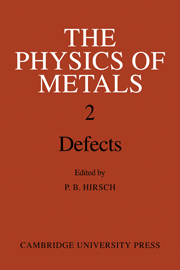3 - Observations of defects in metals by electron microscopy
Published online by Cambridge University Press: 04 August 2010
Summary
INTRODUCTION
It is now just over ten years ‡ since the first observations of dislocations in metal foils by transmission electron microscopy were reported by Hirsch, Home and Whelan (1956) and independently by Bollmann (1956). Since that time the technique has been applied to such a variety of problems in crystal and metal physics and the literature on the subject is now so voluminous that it is impossible in a chapter of this length to give an exhaustive review. Instead the author intends to concentrate first on an exposition of the principles of the technique (sections 3.2 and 3.3) both from the practical point of view and from the point of view of theories of interpretation of image contrast. Some applications to various problems in metal physics will then be described (sections 3.4 and 3.5), which will mainly be illustrative of work done in the Cavendish Laboratory. For this the author makes no apologies in view of the above remark, believing that this work is fairly typical of current applications of the technique.
EXPERIMENTAL TECHNIQUES
Preparation of thin specimens for transmission electron microscopy
Metallic specimens suitable for examination by transmission of electrons in the electron microscope must be of the order of a few (about two) thousand Ångstrom units in thickness or less depending on atomic number. Several methods exist for preparing thin specimens:
Chemical deposition and electrodeposition from solution.
Vacuum evaporation onto a suitable substrate followed by stripping.
[…]
- Type
- Chapter
- Information
- The Physics of Metals , pp. 98 - 151Publisher: Cambridge University PressPrint publication year: 1976
- 1
- Cited by



